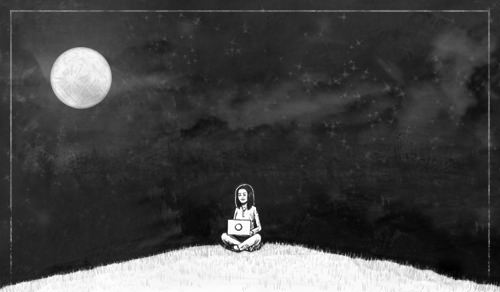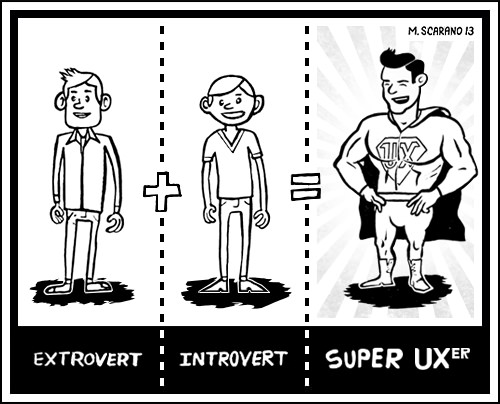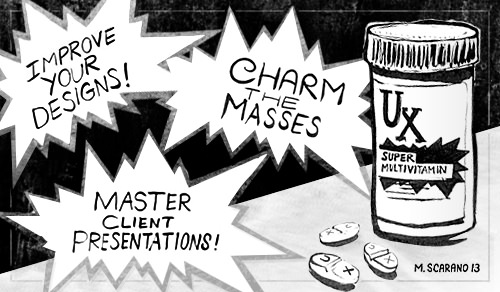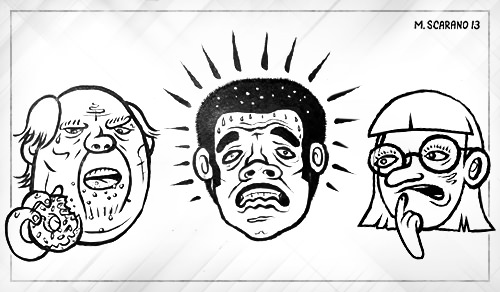Incorporating More Quiet Into The UX Design Process
Behind every successful design is a dynamic creative team, and it takes all kinds of personalities and skills to get the job done. However, the culture and expectations of a design agency are often largely centered on one outspoken, gregarious personality. Things such as group brainstorming, on-the-fly presentations and open workspaces have become the norm in most design agencies.
But the stereotypical extrovert is just one of the personalities that make up a successful team. A lot of people who excel at and are passionate about design — specifically UX design — are actually introverts. This means that, in fostering cultures that celebrate the extrovert, design teams could be losing out on the brainpower of folks who contribute at their highest level when they have quiet and privacy to focus.
So, how can we better balance our teams and elevate extroverts and introverts alike?
As introverted UX designers ourselves, we’ve been unsurprisingly passionate about finding answers to this conundrum. So, we set out to discover just how many designers tend to be more of the Lone Ranger type, and also uncover what makes them successful, what makes them tick and how they use their introverted qualities to round out their teams and create great designs and experiences.
We also uncovered some great anecdotes and debunked a few myths along the way. We poured over findings from a survey of more than 100 people about the topic, as well as six one-on-one interviews, a group discussion (ironically) with 20 UX designers and a handful of anecdotes from some of our introverted colleagues and friends.
Our goal in speaking with introverted designers and embarking on this project was not to publish a scientific study, but rather to collect stories and share how others with such similarities use their strengths and overcome obstacles. If you find yourself to be on the extroverted end of the spectrum, we hope to illustrate for you the differences in the way your introverted team members, users and clients communicate and work, so that you might find additional ways to use those differences in skills to everyone’s advantage.
Here’s what we learned.
So, What Is An Introvert Exactly?
Although there is no concrete definition of introversion, a common observation among experts is that introverts derive energy from being in solitude and are more comfortable with less stimulation. Originally categorized by Carl Jung, an introvert is defined as a person whose interest is generally directed inward toward their own feelings and thoughts, versus the extroverted focus on the outside world.
In her book, Quiet: The Power of Introverts in a World That Can’t Stop Talking (the book that inspired our article and project), Susan Cain explains that introverts recharge their batteries by being alone, whereas extroverts recharge by socializing, and that “introverts often work more slowly and deliberately. They like to focus on one task at a time and can have mighty powers of concentration.” The solitude is what introverts crave, which fosters a strong combination of creativity and persistence.
Cain’s research on introversion paints a picture of a world in which introverts not only tend to possess incredibly valuable traits, such as persistence, concentration, insight and sensitivity, but make up a powerful force of the world’s most impactful thinkers — folks like Albert Einstein, Rosa Parks, Steve Wozniak, Charles Darwin, Steven Spielberg and Mahatma Gandhi.
Marti Olsen Laney states in her book The Introvert Advantage: How to Thrive in an Extrovert World that, if allowed enough downtime, introverts can use perseverance to focus deeply, think independently and foster creativity.
If you are wondering whether you fall into the introvert category, see whether some of the following qualities cited in Susan Cain’s “Quiet Quiz” resonate with you:
- You prefer one-on-one conversations to group activities.
- You often prefer to express yourself in writing.
- You enjoy solitude.
- People tell you that you’re a good listener.
It’s important to note that introversion and extroversion appear along a spectrum and are not two extreme and specific buckets of traits. People are complex, of course, and no two introverts or extroverts are exactly alike. We have met some introverts who are extremely outspoken, and some extroverts who describe themselves as antisocial or shy. Many extroverts find that they thrive just as well in long periods of focused solitude as their introverted counterparts.
Exploring UX Through The Lens Of The Introvert-Extrovert Spectrum
We were excited to apply the newfound idea of exploring which traits of introverts and extroverts play as strengths in our field of UX design in an agency or client-based setting. We began our research by facilitating a focus group-type conversation with 20 people in the UX field, asking them to identify themselves as an introvert, extrovert or ambivert (someone who possesses characteristics of both introverts and extroverts). We then asked them to share their stories and opinions on how they best work and what they find easy or challenging in the UX industry.
Because a large part of any UX professional’s job is to study and evaluate processes that humans find either easy or hard, the differences in how all three types do their best work were naturally curious. While some felt energized by walking up to coworkers and initiating an organic conversation, others avoided such interaction by getting up at 4:00 in the morning just to be able to work in solitude.
Many introverts and ambiverts in the group mentioned the need to match the ease of their extroverted counterparts in taking a more persuasive and stronger stance with clients, or in being more at ease with the parts of the job that require a lot of socialization with clients and strangers. In fact, many even expressed pride in working hard to become a “converted extrovert”.
True, it’s important to practice getting out of your comfort zone and to be confident in expressing your ideas — but is attempting to change your introverted nature the only path to success for those who don’t possess strong extroverted skills? How can we become more successful by recognizing and utilizing our differences as UX professionals?
In addition to the focus group, and in order to discover how introverted UX leaders (particularly in a client-focused agency) succeed in their roles, we also conducted an online survey with people in the tech industry to identify candidates to interview. Because of Cain’s extensive research on the subject, we chose to ask the questions from her Quiet Quiz in order to determine who is an introvert, extrovert or ambivert. Of the more than 110 designers, developers, project managers and other professionals in the tech industry who took the survey, 55% were introverts, 31% ambiverts and only 14% turned out to be extroverts.
From that survey, we chose six leaders in the UX design industry who were willing to let us pick their brains in one-on-one interviews about what it takes to be successful as an introvert in a UX agency.
In our interviews, we discussed questions like these:
- “What’s your ideal work environment?”
- “How do you work best with your coworkers and clients?”
- “What kinds of introverted qualities help you in your job?”
- “Which qualities can be challenging, and how have you dealt with those challenges?”
We heard deeply personal stories about lessons learned when going against one’s natural tendency and pretending to be a gregarious and spontaneous conversationalist, and inspirational stories about how displaying quiet confidence can be effective when dealing with powerfully strong voices in a large meeting.
So many answers and experiences shared were so surprisingly similar that we knew we were on to something. We stumbled upon a subculture of sometimes proud, sometimes closeted introverted UX practitioners who all feel like they face similar challenges alone. Simply being asked questions about their job through the lens of introversion was enough to make most of our interviewees feel less alone and more empowered. We hope these findings inspire others in similar positions and enlighten all of us on the introvert-extrovert spectrum of the amazing differences in strengths we all possess, which, when combined, make up super-teams of UX professionals.
The Powers Of Quiet Confidence
Not surprisingly, the common threads in our own findings match closely with the introverted traits identified by Cain and other experts in the field. So many of these traits help a UX designer in their career. But before getting into some of the trends that we noticed in our one-on-one conversations, we should note that the following traits identified are also found in many who identify themselves as extroverts and ambiverts. No matter where we are on the introvert-extrovert spectrum, we all could stand to celebrate the side of us that usually takes the back seat — that silent yet powerful creative force that helps us to process and solve complicated UX problems.
The focus of our qualitative research was on finding commonalities among UX designers who strongly identify with an introverted lifestyle. We felt strongly about encouraging others to celebrate and appreciate their qualities. What do introverts do well that makes them natural-born UX people, and what can we learn about these talents in order to bring about better communication, better UX teams and, ultimately, better products in all of us?
Here are some solid strengths that we uncovered from conversations with introverted UX leaders.
Introverted UX’ers Are Great Listeners
Because they tend to be quiet, reflective and observant in their day-to-day affairs, the information-gathering skill of the UX designer is a natural-born capacity of the introvert. The interviewees we spoke with expressed gratitude that they possess the gift of anti-gab, instead feeling at home in the role of asking questions, observing conversations and deriving true meaning from their observations.
They Are Relatively Humble
Because they would rather avoid the spotlight, introverts are comfortable in the shadow, elevating those around them. Some of our interviewees are not inclined to be upset if they are not publicly acknowledged for their good work, just as long as their ideas are being put to good use.
They Make Great Problem-Solvers
Thinking through the intricacies of a problem is not mundane to an introvert. On the contrary, they tend to find it exciting, as long as they have the time to analyze and problem-solve in solitude. This is, of course, a great asset when combing through a large amount of data to figure out how to create a great user experience for a product.
They Enjoy Putting Themselves In Other People’s Shoes
Introverts tend to be naturally empathetic, which can be incredibly helpful in creating delightful experiences for end users.
They Over-Prepare
Introverts tend to take time to fine-tune their speaking points when presenting to clients. Additionally, they think ahead about possible questions that others might have about their work, instead of winging it and risking saying something they might regret later.
They Make Good Leaders
Contrary to the popular belief that extroverts make the best leaders, introverts also make great leaders — they just do it differently. Especially when running project workshops, our UX leaders prefer to lead through a more facilitative style, whereby they let others run with their ideas, gather consensus from all involved, and work through differences collaboratively.
They Can Read A Room
Their empathetic and sensitive nature helps introverts read a room and understand other people’s reactions and emotions. Many of our interviewees expressed gratitude that they possessed this ability to pick up on the feelings of those around them, and to understand the general emotional atmosphere in a client or team meeting. This has been a huge asset in their communications throughout their careers.
How Introverts Can Set Themselves Up For Success
In our own experience as UX designers and from speaking with other introverted UX designers, knowing that these introverted qualities can be leveraged as strengths is half the battle. Additionally, managing stress, preparing thoughtfully and organizing your workspace and workflow to maximize creativity and productivity are important elements of success for all designers. However, introverted designers in particular can set themselves up for success in a few additional ways.
Take Time To Recharge
A common trend we found was that, even when a day full of interaction with others has been enjoyable and successful (such as in workshops, user interviews, collaboration with clients and teammates, or travel), finding time to be alone in order to recover and “recharge your battery” is regarded by introverts as a crucial “survival mechanism.” One interviewee said, “I have a bank, and I need to spend time building up my reserves before and after travel. Being more self-aware of how these seemingly normal parts of the job can really pull on you after a while is helpful.”
Guard Your Focus Time
Of the more experienced UX designers we spoke with, most had formulated a strategy for building focus time into their day. Many noted that finding a quiet place to think at an agency can be tough, and that putting on their headphones is a good way to drown out the noise around them. One designer we interviewed takes regular 10-minute breaks when she feels stuck; another said that his best ideas come in a slow burn after a meeting, in the shower or when taking a break during the day.
One introverted UX designer said she does everything she can to guard her thinking time ahead of travel and big meetings — she’ll actually block her calendar so that she can process and plan alone. Everyone we spoke with loves having time to think through a problem on their own.
Prepare Well In Advance So That You Don’t Have To Wing It
All six of the UX designers we interviewed take time to prepare — and often over-prepare — for occasions when they will be in the spotlight, whether running a workshop, speaking at a conference, or leading a roomful of clients to discuss a design. Their techniques include the following:
- Make a checklist of items to do or discuss.
- Plan ahead for what could go wrong or where people might get stuck.
- Plan how to back up your ideas verbally before a meeting (“Always be thinking, ‘When this question comes up, this is what I’m going to say.’”)
- Carve out some alone time, whether early in the morning, late at night, while commuting or by taking notes alone. Planning what you want to say and how to say it is helpful.
Seek Out An Environment That Is Equal Parts Quiet And Social
Almost all of our interviewees work best in environments that balance quiet space and social time with others. When asked about the office, most said they enjoy the open floor plan found in many design studios, as long as they are able to put on headphones or find a quiet area to focus without interruption. One UX designer said this:
"I actually like that there are not walls in the office. I like the culture and feel, but don’t always like that there’s no place to have quiet time. I like knowing there are people around, just not right next to me."
How Best To Work With Introverts
Not surprisingly, introverts tend to prefer certain structures and ways of communicating over others. The most challenging type of communication is in large groups, in which more aggressive personalities, better suited to debating and persuading on the fly, tend to thrive.
Therefore, if you’re an extrovert, making the most of the time available and getting great ideas from everyone might mean honing in on the quieter folks in the room to note their comfort level. If you’re an introvert, effectively sharing your ideas could mean breaking down large client meetings into more frequent meetings with smaller groups, structuring workshops in a way that enables you to be a facilitator instead of a lecturer, and communicating in a style that comes more naturally to you.
Below are a few tips we gleaned from our conversations.
Introverts Thrive One On One and In Small Groups
Whether it’s a whiteboarding session with teammates, a one-on-one user interview or a planning session with clients, introverts are invigorated by working with one other person or in a small group. This contradicts the notion that introverts prefer to work alone all of the time. Said one interviewee:
"I like to collaborate. If you’re introverted, people think you just want to put your headphones on and hide, but that’s not true at all."
All of our interviewees recognize the value and benefit of collaboration, but they just find that collaborating with one other person or in a small group to be of greater value and less of an emotional drain. Much like pair programming, one person found their groove by practicing pair design:
"I believe in the value of pair design: The two of us could come up with a better solution. I believe in that. We all take in a different perspective and remember different things, and working it through with someone is valuable."
The prospect of having a more impactful voice by speaking with one or a few people, versus working in a larger group, in which the most outgoing voice usually wins, is enticing. Said one person:
"I like internal design meetings, brainstorming sessions, small team whiteboarding sessions, where you poke holes in ideas and challenge them… It’s a small group, and if you’re lucky, you get paired with people who don’t steamroll the entire process."
After Collaborating, Introverts Need Time Alone To Process
Immediately after collaborating or interacting with others for a project, introverts get a lot of value from spending time alone to process their findings and to focus on their tasks:
"I like to gather, gather, gather, which is a social activity, then retreat to a cave, work on it, then bring it back. I need people and I gather info, but then I have to go be alone to work it out and process it and own it and come up with a solution to bring it back."
This repetitive process of “gathering the pieces of the puzzle,” taking them back to process them in solitude, before coming back with more ideas was consistent with all of our interviewees, who view it as a crucial element of success in their jobs.
They Strongly Dislike Aggressive Communication Styles (But Realize It’s Sometimes Part Of The Job)
When in a group in which a strongly opinionated voice is dominating the conversation, an introvert might naturally tend not to participate. Rapidly thinking on one’s feet when arguing a point is a skill envied by many introverts.
“Debating doesn’t work well for me,” said one UX designer. “If I debate with you and you’re an extrovert, you’ll be perceived as the winner just because people will think you sound smart, and I’ll pull out of the situation.” Furthermore, the more sensitive and quiet style of introverts often clashes with the louder, more confrontational style of extroverts. One person said:
"I don’t like confrontation… I really avoid it as much as I can. I found it challenging in my work, where you really have to go up against someone or throw down a design decision and justify what you’ve made."
However, dealing with clients or coworkers whose style is confrontational is sometimes unavoidable. Figuring out what they can do to make such situations go more smoothly is a key survival strategy for the UX leaders we spoke with, and their advice to other introverts out there is plentiful.
- Listen first. When dealing with an extroverted or even pushy personality, use your listening skills to help put yourself in an authoritative position.
“No one knows as much about the client as the client does… [When you] listen to them and hear their ideas, and make sure you have valid statements to back up your ideas, they will usually listen to you.” * Assume the role of a relayer of information, rather than the expert.This critical piece of UX design can make the task of relaying a recommendation assertively a bit easier.
“It’s never what I think. It’s always about the user… I’m not saying no because you’re wrong and I’m right, but I’m just saying what we heard in the research. I’m not the expert on your product, but I AM good at researching what your users want.” * Saying “I don’t know” is OK.
“It has taken me a long time to get to the point where a client asks a question that I don’t know the answer to and to be comfortable saying, “Gee, I don’t know. Can you explain more?” Or, “I’ll get back to you on that…” I’ve regretted saying something just because I felt like I had to have an opinion.” * Don’t be afraid to ask for help. When dealing with a confrontational personality, one person said:
“In retrospect, I don’t think I did a good enough job at expressing how I was really challenged to deal with this person. I didn’t want to be perceived that I couldn’t do it… Being introverted has an aspect to that. It’s hard to admit vulnerability, and hard to know when it’s OK to be vulnerable.” * Leverage your extroverted teammates.
“I love having extroverts on a team in situations where, if I’m stumbling on something, they’re usually able to pipe in. It’s nice to have extroverts who can make clients feel confident that we know what we’re talking about.”
Leveraging The Quiet Side In All Of Us
Perhaps you lie towards the extroverted end of the spectrum but you work with or lead a team that includes introverts and want to find out how to leverage the strengths of the entire team. Or perhaps you work with introverted clients or users and wish there was a better way to get more immediate feedback from them.
You can get some tremendous benefits from understanding the skills and challenges of your introverted counterparts and from, consequently, leveraging their strengths. Your natural talent at communicating with others clearly, engagingly and persuasively, coupled with the tendency of introverts to quietly analyze their surroundings while hunkering down on the details, can make for a super-team of people with diverse qualities and skill sets and capable of high-quality results.
Here are some ideas to get the most out of working with your introverted teammates.
Recognize When Assertiveness Or Eloquence Is Being Mistaken For A Good Idea In A Large Group
If you find yourself contributing often or leading discussions in which important decisions are being made, especially when interruptions and fast or loud exchanges are happening, try to slow down the discussion and provide a clear opportunity for others to ask and get answers. Note whether everyone’s opinion has been voiced.
In “The Rise of the New Groupthink,” an article also written by Susan Cain, she states, “Decades of research show that individuals almost always perform better than groups in both quality and quantity, and group performance gets worse as group size increases.” Often times, the quietness of introverts in such settings indicates not so much a lack of interest or difference of opinion, but rather the challenge they face in matching the level of intensity in the meeting.
“Even if their intentions are good, but they’re more passionate and aggressive, it can make me shut down,” says one UX designer about the challenge of dealing with a confrontational style in meetings. Another explains that, “Nothing makes you feel more small than when others are talking over you.”
A big obstacle to getting all great ideas on the table could simply be the aggressive communication style of some participants.
Understand That Introverts Are Not At Their Best When Put On The Spot
Instead of being forced to share their ideas in meetings, where conversation happens on the fly, introverts are often much more effective when they have even a short amount of time to think through a scenario first. In an agency, where a lot of group thinking and brainstorming is required, distributing the agenda in advance would help. This gives introverts the time to thoughtfully prepare and to more easily contribute to the meeting.
Our own interviewees expressed appreciation that we sent out our questions ahead of time so that they had time to think about scenarios and answers. When asked how she best functions when working with colleagues, one interviewee resolutely stated:
"I’m not a huge fan of meetings, but a well-structured meeting is not a bad thing. I like to go into a meeting with a really clear idea of why we’re here and what we want to get out of this. How can I define the best way to utilize our time? If we can’t figure that out, I’ll reschedule."
Take A Cue From Each Other
Sometimes simply recognizing each other’s soft skills can have a monumental impact on a team’s dynamic. Perhaps one person prefers to do the talking in contextual interviews, and another is more comfortable taking notes or organizing. Talking openly in order to know who prefers to take on which role in a project can make the working environment more pleasant and efficient.
Eventually, if we are open and humble enough to talk about our strengths and weaknesses with one another, we can take cues from how others work in order to become more comfortable employing those skills ourselves. For example, if you always want to work in a group to get things done, try out another method once: hold an initial and short group brainstorming session, then send everyone off to their “caves” to process the ideas by themselves, before coming back to discuss again. See whether this compromise of working together first and then in solitude is an asset to the group.
Likewise, your introverted counterparts are constantly observing the methods that come naturally to you as extroverts and are taking their own cues. As one introverted UX designer explained:
"[My extroverted colleague] just dives in. It came naturally for her to come in and set up a weekly meeting with the client. Now I do that, too — it seemed uncomfortable to me at the time. I appreciate how easy it is for her to network."
Be Cool With Quiet
It’s very clear that the successful introverted UX leaders we spoke with got to where they are not by attempting to change their nature, but rather by recognizing and using those introverted qualities to their advantage. Expressing confidence with clients and backing up your own ideas do not have to come from being the most persuasive debater or from an aggressive style.
One of the UX’ers we spoke with ended our interview by saying this:
"We need listeners. Be comfortable with your quiet. Be confident in your introversion. It’s not a flaw. I used to see it as awkward. Over time, I’ve come to recognize the strengths it offers."
We couldn’t agree more.
Likewise, the UX world needs great communicators, multitaskers and risk-takers. We need people who are not afraid to shout out that UX makes the world a better place, who are not afraid to stir the pot by showing us exciting new ways to view our industry. To create a great and successful UX community, we need both loud and quiet, group work and solitude, intense singular focus and thinking on several planes at the same time.
In the very near future, we hope to hear about wildly successful designs delivered by UX teams that fully incorporate ideas from the quietest corners of the office, teams that respect both the quiet strengths and bold ingenuities that all personalities have to offer. Life is the richer for them.
Further Reading
- How To Build An Agile UX Team
- Effectively Planning UX Design Projects
- How To Spark A UX Revolution
- How To Become A UX Leader













